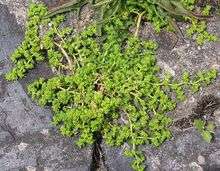Herniaria glabra
| Herniaria glabra | |
|---|---|
 | |
| Scientific classification | |
| Kingdom: | Plant |
| (unranked): | Angiosperms |
| (unranked): | Eudicots |
| (unranked): | Core eudicots |
| Order: | Caryophyllales |
| Family: | Caryophyllaceae |
| Genus: | Herniaria |
| Species: | H. glabra |
| Binomial name | |
| Herniaria glabra L. | |
Herniaria glabra, known as smooth rupturewort, is a plant of the family Caryophyllaceae. Growing in North America and Europe, it is believed to have diuretic properties. It contains herniarin, a methoxy analog of umbelliferone[1]
Nomenclature: Pronounced her-nee-ah-ree-a gla-bra, it is named for its historical use as a medicinal plant. It was formerly used to treat cuts - herniated skin. The species name glabra means 'smooth' or 'hairless'. Hence, it has a common name of Rupturewort, also referred to as Smooth Rupturewort.
Features: Herniaria glabra is a relatively unknown, easy to grow, low maintenance, perennial. In Plant nurseries it is sometimes also known as ‘Green Carpet’..
Nearly indestructible, Herniaria glabra is an excellent, drought tolerant, lawn substitute.
It is soft to walk on and can take quite a bit of foot traffic, as long as it is not continual. Never growing taller than 1½in (4cm), the fairly flat plant spreads 12 to 24in (30 to 60cm).
The tiny tight green leaves form an extremely dense evergreen creeping ground-cover. The deep green foliage becomes bronze in winter. In the early summer, it bears minuscule, insignificant white flowers.
The plants is gently coumarin-scented, the sweet odour is similar to the scent of newly-mown hay
The growth rate is fairly slow and easy to control. Plants can easily be divided in spring.
Conditions: Herniaria glabra prefers well drained soil in full sun or light shade. It is a creeper that spreads easily in all directions, filling up to two feet per plant. It is not fussy about soil and will happily grow in poor soil and gravel. It is an easy-care perennial. It has one long tap root (as opposed to many surface roots like Creeping Thyme), making it it drought tolerant. It is also extremely hardy to around minus 30°C (-20°F).
Scent: Herniaria glabra is gently coumarin-scented. Coumarin is a fragrant chemical compound found in many plants, notably in high concentration in the tonka bean (Dipteryx odorata), vanilla grass (Anthoxanthum odoratum), sweet woodruff (Galium odoratum), mullein (Verbascum spp.), sweet grass (Hierochloe odorata), cassia cinnamon (Cinnamomum aromaticum) and sweet clover (Fabaceae spp.). The name comes from a French word, coumarou, for the tonka bean. It has a sweet odour, readily recognised as the scent of newly-mown hay, and has been used in perfumes since 1882. Sweet woodruff, sweet grass and sweet clover in particular are named for their sweet smell, which is due to their high content of this substance. It has been used as an aroma enhancer in pipe tobaccos and certain alcoholic drinks.
Plant Uses: Groundcover, Rock Gardens, walls and crevices, Edging, paths and garden steps. Containers and Hanging Baskets, Bedding Planting. Over planting bulbs. Slopes, Bark replacement. It's also good for growing between flagstones. Its trailing habit also lends itself to rock gardens walls and bedding schemes. Lawn Replacement, even withstands foot traffic.
Origin: Native to temperate areas of Europe and Russian Asia, extending into Scandinavia, but not to high latitudes. A native of Britain, especially southern and central England.
They are small annuals or undershrubs, with small green flowers crowding along the stems, intermixed with leaves. The genus Herniaria was formerly included in the family Illecebraceae, but is now segregated with the Caryophyllaceae, related to Carnations and Dianthus. There are very few species of the genus.
Sowing: Sow in spring or in autumn. Prepare pots or trays with good free draining seed compost. Moisten by soaking the pots in water, then drain. Surface sow two seeds per pot or cell and press them gently down to firm them in. Cover the seed with a fine layer of vermiculite if you have it. Seal pots in a polythene bag or cover trays with clear plastic lids until after germination. It is important to keep soil slightly moist but not wet. Remove the polythene bag once the first seedlings appear.
Germination usually takes 14 days at temperatures around 68 to 71°F (20 to 22°C).
When they are large enough to handle transplant the seedlings to 3 to 4in (7 to 10cm) pots to grow on. Place the pots in a coldframe or unheated greenhouse to grow on. Before transplanting the plants outdoors, hardened the plants off gradually by placing them outside in a sheltered position during the day; bring them in at night to avoid frosts. Space plants 8in (20cm) apart.
Cultivation: Cover substrate with vermiculite or mulch to retain water and keep your eye on small plants until they establish themselves. Remove damaged foliage in spring and fertilise with a complete balanced fertiliser. Don't fertilise after mid September (USA).
Odd Fact: At eleven letters in length, Rupturewort is the longest word in the English dictionary that can be spelled by the top row of letters on a qwerty keyboard.
References
External links
 Media related to Herniaria glabra at Wikimedia Commons
Media related to Herniaria glabra at Wikimedia Commons